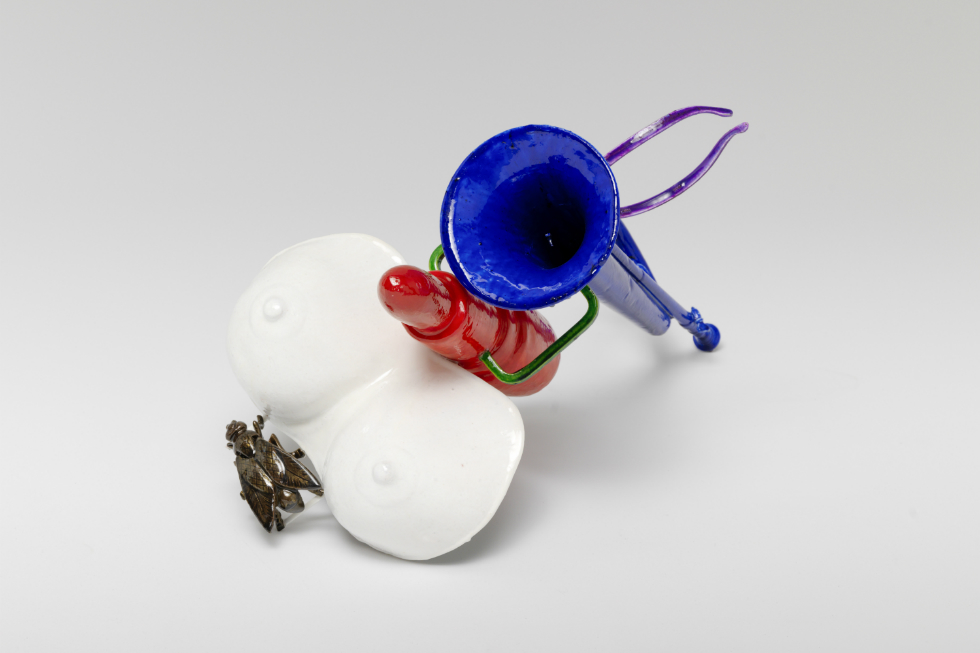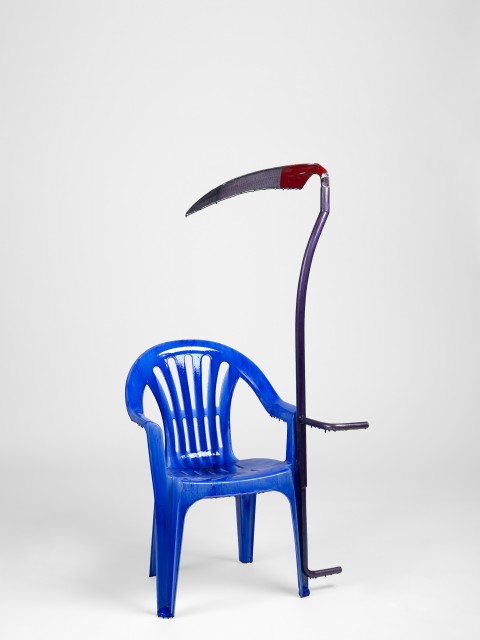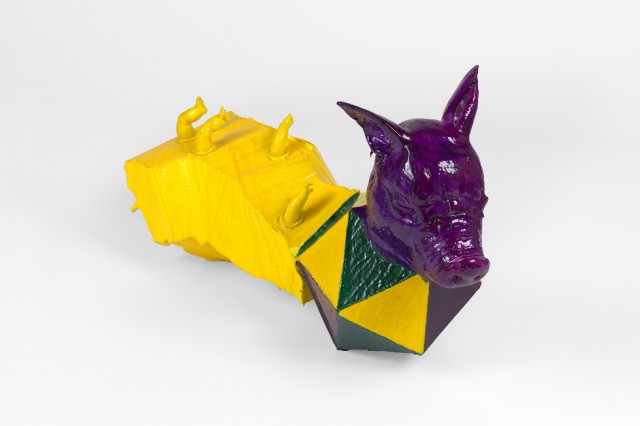“The naughty smirk of the vivisectionist”: Jean-Luc Moulène’s Larvae And Ghosts — Reviewed

Eviscerated pigs, light-hearted death threats, and the absurdity of living; Jay Bernard encounters Jean-Luc Moulène at Thomas Dane Gallery…
It’s raining, and someone has just handed me a poem in French:
“A noir, E blanc, I rouge, U vert, O bleu : voyelles, / Je dirai quelque jour vos naissances latentes:”
It’s Arthur Rimbaud’s “Voyelles” – “Vowels”. In English:
“Black A, White E, Red I, Green U, Blue O: vowels, / One day I will speak of your secret birth cries:”
It’s a disarming move, handing someone a poem without translation; they’re on the back foot. What if, god forbid, they don’t speak French? How will they unlock the secrets of the art they are about to see? That’s their problem.
And it was mine for about five minutes before I realised that Jean-Luc Moulène’s latest exhibition at the Thomas Dane Gallery (London), Larvae and Ghosts, was taking itself less seriously than I had supposed. The Guardian reported the exhibition as “hilarious”, which feels a little inaccurate, but Moulène’s clearly playing with his practice, or rather, continuing a playful practice; the daubing of colourful, high gloss resin on a plastic chair, as in La Faucheuse, Paris isn’t hilarious exactly – particularly when there is a scythe bolted to its side, dripping purple – but something else. Light-hearted death threat? Or maybe the kind of humour attained after a long stretch in the gulag. There are no belly laughs here, no ha-has, but there is the naughty smirk of the vivisectionist.
This is an artist who has arranged cauliflowers, sculpted cartilage as well as bronze, presented photography as well as “objects” (never “sculptures”), documented a single Parisian tree, and fused a balloon with a human skull. His show Products of Palestine exhibited in the same space in 2007, in which Moulène collected and photographed 58 sanctioned products from the West Bank and occupied territories. Later this year, he will show at the Pompidou, and is expected to interrogate our digital lives, a material even trickier than wood or bone. His work has been described in the words of Antonin Artaud, as a “body without organs” – a cohesive form without an internal, hierarchical structure – and indeed his self-description is as an artist who eschews classification.
So it’s the process of evisceration, rearrangement and discovery that makes Moulène’s latest work interesting. Split over two sites, the first gallery houses drawings of animals spliced together. An ant/mammal (we assume it’s mammalian insofar as it could be anything from a goat to a genuflecting faun), fittingly entitled Mix, messes around with scale, versus Creature in which the cut is less severe – the purple/green ink bleeds into and worries the line where its belly is cleaved, contrasting again with Bubu, a kind of hottentot venus studded with gemstones. These are watercolours, whimsically effacing the severances they depict and you might say unremarkable, if humourous, compared to the sculptures they accompany.

In the centre of one room lies two greyish lumps. Animal forms – Donkey, actually – but presented face down, with none of the features to guide you. This piece, in which Moulène casts a donkey skull in concrete then splits it open, has an eerieness and command that undercuts the watercolours; the double-enquiry of skull-casting and skull-preservation, is beautifully succinct and draws you in with simple Bressonian insight.
Indeed the whole exhibition is summarised by Moulène as the “simple” idea of “giving concrete existence to mental images”, and that is patent not only in Donkey but the more grotesque Fairy Fantasy, which is a pig’s head on a body composed of acid-induced geometry and baby hands. The same sickly resin used in La Facheuse, Paris is here again, as it is in La Voyelles, a tricolored, literal structure that corresponds to the coloured vowels in the poem – the blue trumpet is O, the lipstick a very lurid I – and they all rest haphazard with a fly at the bottom of the pile lending reality to the conceit, as if it were a vanity.
The overwhelming feeling I came away with as I left to enter the next phase of the exhibition a few doors down, was of someone presenting life as a series of ironies, half-jokes and pointed observations about the absurdity of living. The punchline is death, of course, and this lands well as you enter the second gallery: arranged on crisp white napkins are an array of statues that have been spliced together.
I fished for an interesting story as to where these statues came from and, unluckily, they were probably sourced wholesale, but then again that speaks to the joking/not-joking feel of the work. Moulène has very wittily presented a kind of graveyard in which assumptions go to die – the assumption of fluidity, for instance, is gone once you notice the awkwardness of the splice. The statues, all grey and mottled green from age, seem to be fluid, formal trinities: Bending, Indexes, Purple Graces (that resin again, the same nauseating purple as the scythe) all reveal undulate (but decisive) amputations from their original context, and the texture of the inside is like the oaty texture of breast tissue in some, like a cow’s tongue in others. Yet the experience is fleshless and abstracted without feeling arid.

It’s particularly fun to walk around the back of the statues and witness a cemetery of contorting figures whose forms hark back to an older age, but whose embodied material is a composite of old and new: concrete is of ancient origin but latterly made with newer materials such as cement (or, “ciment fondu” as it is known in French, which feels suitably camp). If you want further evidence of Moulène’s refusal of categorical and material expectations, his 2014 New York show Torture Concrete, besides maybe the floor, featured no concrete at all. Donkey, previously alone in the centre of the room, is refigured as Pig, which lays open and eviscerated, off to one side. Poor pig. How funny that it should end up bits of teeth and mandible encased in concrete, on a section of cut cloth, without a proper burial.
I can’t think of a more profound juxtaposition than a live material and a dead one, and Moulene provides this contrasting image with simple ease. Even Cat/Skull manages to feel fresh, largely because the skull element is so disarmingly close to the cat element (which might also be a nod to our indefatigable online cat obsession); the slash in the title is invisible and the ellision serves as a memento mori: remember that you will die / remember to find it funny.
Jay Bernard
See Jean-Luc Moulène: Larvae And Ghosts at Thomas Dane Gallery, London, from 15 April to 28 May 2016





